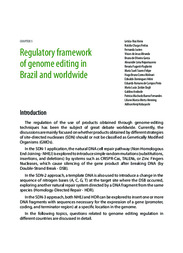Embrapa Pecuária Sudeste
 Busca de Publicações
Busca de Publicações
Regulatory framework of genome editing in Brazil and worldwide.
Autoria: VIEIRA, L. R.; FREITAS, N. C.; JUSTEN, F.; MIRANDA, V. de J.; GARCIA, B. de O.; NEPOMUCENO, A. L.; FUGANTI-PAGLIARINI, R.; FELIPE, M. S. S.; MOLINARI, H. B. C.; VELINI, E. D.; PINTO, E. R. de C.; DAGLI, M. L. Z.; ANDRADE, G.; FERNANDES, P. M. B.; MERTZ-HENNING, L. M.; KOBAYASHI, A. K.
Resumo: The regulation of the use of products obtained through genome-editing techniques has been the subject of great debate worldwide. Currently, the discussions are mainly focused on whether products obtained by different strategies of site-directed nucleases (SDN) should or not be classified as Genetically Modified Organisms (GMOs). In the SDN-1 application, the natural DNA cell repair pathway (Non-Homologous End-Joining - NHEJ) is explored to introduce simple random mutations (substitutions, insertions, and deletions) by systems such as CRISPR-Cas, TALENs, or Zinc Fingers Nucleases, which cause silencing of the gene product after breaking DNA (by Double-Strand Break - DSB). In the SDN-2 approach, a template DNA is also used to introduce a change in the sequence of nitrogen bases (A, C, G, T) at the target site where the DSB occurred, exploring another natural repair system directed by a DNA fragment from the same species (Homology-Directed Repair - HDR). In the SDN-3 approach, both NHEJ and HDR can be explored to insert one or more DNA fragments with sequences necessary for the expression of a gene (promoter, coding, and terminator region) at a specific location in the genome. In the following topics, questions related to genome editing regulation in different countries are discussed in detail.
Ano de publicação: 2021
Tipo de publicação: Parte de livro (capítulos de livros, trabalhos e resumos publicados em anais ou em coletâneas)
Unidade: Embrapa Soja
Palavras-chave: Biotecnologia, DNA, Engenharia Genética, Genética Vegetal, Legislação

